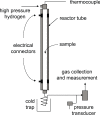Biomedical and forensic applications of combined catalytic hydrogenation-stable isotope ratio analysis
- PMID: 19662175
- PMCID: PMC2716821
Biomedical and forensic applications of combined catalytic hydrogenation-stable isotope ratio analysis
Abstract
Studies of biological molecules such as fatty acids and the steroid hormones have the potential to benefit enormously from stable carbon isotope ratio measurements of individual molecules. In their natural form, however, the body's molecules interact too readily with laboratory equipment designed to separate them for accurate measurements to be made. Some methods overcome this problem by adding carbon to the target molecule, but this can irreversibly overprint the carbon source 'signal'. Hydropyrolysis is a newly-applied catalytic technique that delicately strips molecules of their functional groups but retains their carbon skeletons and stereochemistries intact, allowing precise determination of the carbon source. By solving analytical problems, the new technique is increasing the ability of scientists to pinpoint molecular indicators of disease, elucidate metabolic pathways and recognise administered substances in forensic investigations.
Keywords: fatty acids; hydropyrolysis; stable isotopes; steroids.
Figures







References
-
- Becchi M, Aguilera R, Farizon Y, et al. Gas-chromatography combustion isotope ratio mass-spectrometry analysis of urinary steroids to detect misuse of testosterone in sport. Rapid Communications in Mass Spectrometry. 1994;8:304–308. - PubMed
-
- Beroza M. Determination of the chemical structure of microgram amounts of organic compounds by gas chromatography. Analytical Chemistry. 1962;34:1801–1811.
-
- Coppen JJW. Steroids: from plants to pills—the changing picture. Tropical Science. 1979;21:125–141.
-
- Debruyckere G, de Sagher R, Van Peteghem C. Clostebol-positive urine after consumption of contaminated meat. Clinical Chemistry. 1992;38:1869–1873. - PubMed
LinkOut - more resources
Full Text Sources
Other Literature Sources
